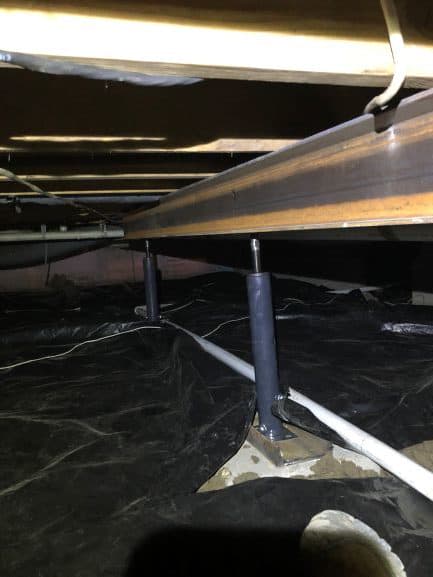
When a floor slopes towards the center of the house, or sags in the middle, it usually indicates an issue with the main beam or its supports. Have you ever ventured into your crawl space, to look at the wooden flooring structure below your home? Why not? Sure, they’re dark cramped spaces with dirt floors and cobwebs everywhere- but other than that they’re fun places to hang out.
Obviously, I’m kidding. Most homeowners don’t enter their crawl spaces unless they’re clean and encapsulated and with good reason. (You wouldn’t get my arachnophobic self in an untreated crawl space!) But this is where you have to go, if you’re looking for problems in your flooring structure.
Acculevel is a family-owned and operated company that specializes in waterproofing and foundation repair. We’ve restored thousands of homes to secure and healthy structures throughout Indiana and the surrounding states. Our knowledgeable and experienced project managers routinely inspect crawl spaces, looking for damages to the wooden structure or to the foundation, while also watching for any possible water damage issues.
In this article, we’re going to tackle the topic that brought you to this page: a damaged main beam. Some contractors will replace a one wooden beam with another one, but at Acculevel we prefer to replace them with steel beams. I’ll explain why we choose this material, why we believe it is worth the additional costs to homeowners, and provide additional sources of information as we go.
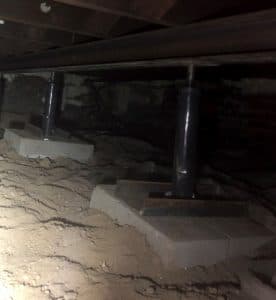 This photo was taken by an Acculevel crew member, after a steel beam and adjustable jacks were installed.
This photo was taken by an Acculevel crew member, after a steel beam and adjustable jacks were installed.
As the name suggests, it’s the large wooden beam that runs the length of your home. The main beam is held up by support posts, usually made of concrete or steel. The floor joists rest on top of the main beam, and the subfloor is built on top of the joists.
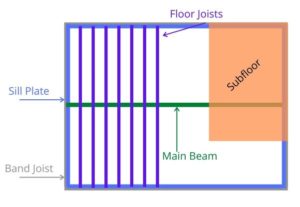
If you have additional questions about the other components in this diagram, or how they are repaired, you can read more about the flooring structure, repair methods, and pricing here.
There are a number of factors that can contribute to a failing center beam. Moisture and insect damage are two of the most common sources of decay.
Sometimes, the beam itself may not be the issue; the supports under the beam can sometimes be the guilty party. Building methods, materials, and codes all change regularly over time.
When your home was built, maybe the supports were built of wood. Those wooden supports would be resting directly on the ground; moisture could seep up into the posts and cause rot. Perhaps the building codes specified the columns had to be concrete, but they could be placed up to 10 feet apart. Over time, the weight of the house can cause the beam to sag between the columns (current building code requires a column every 4-5 feet).
If the beam itself is damaged, it should be replaced. To do this safely, steel jacks should be temporarily installed to hold up the floor joists. Then the beam can be removed and replaced without threatening the stability of your home.
Of course, if the beam is fine, jacks may be the actual needed repair. Depending on the strength of the support columns, you may need steel jacks to replace or supplement the support columns.
In some cases, a wooden shim can be part of the problem. When a home is built, if there is a slight gap between the column and beam, a builder might place a shim into the gap. Wooden shims will compress from the weight of the house, gradually lowering the beam in that area.
Shims are replaced like beams are- a jack temporarily holds up the beam until the crushed wooden piece can be replaced with a steel shim. Acculevel uses steel shims that are significantly wider than the 1.5 inch wooden one in the photo below. Using a larger shim provides more points of contact between the beam and column, which disperses the pressure across the surface and “shares the load,” so to speak.
 This photo was taken by an Acculevel project manager during a routine estimate. The wooden shim has flattened under the weight of the beam.
This photo was taken by an Acculevel project manager during a routine estimate. The wooden shim has flattened under the weight of the beam.
If you have more questions about floor jacks and repairs made to sagging floors, we answer the most frequently asked questions from customers here.
If you’ve talked to other contractors, or done research on their sites, you may experience some sticker shock when I tell you that beam replacement is $150-$225 per foot. Unlike some companies, we usually use steel beams instead of wooden ones. (Disclosure: if a structural engineer specifically calls for wooden beams, we will install them.)
Steel beams are a practical, longer-lasting product. Steel is far less susceptible to moisture damage, immune to insects, and less likely to bend or shift under the weight of your home.
Replacing a rotting wooden beam with another wooden beam is akin to kicking a can down the road. It’s not an issue for a while, but it eventually shows up again. If you address and solve the problems that led to the wooden beam decay, it could be good for a while. But you leave the door open to the same potential problems down the line.
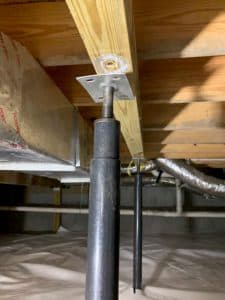 This picture was taken by an Acculevel project manager during a routine estimate appointment. The customer had steel jacks installed, to replace failing columns. But the floor had begun to sag again and he wanted us to check on the repairs.
This picture was taken by an Acculevel project manager during a routine estimate appointment. The customer had steel jacks installed, to replace failing columns. But the floor had begun to sag again and he wanted us to check on the repairs.
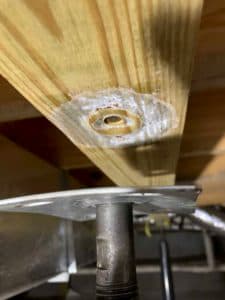 When the jack was lowered, the problem became clear- the wood of the beam is being compressed between the weight of the house and the immobility of the steel jack. Replacing the wooden beam with a steel beam will resolve this issue.
When the jack was lowered, the problem became clear- the wood of the beam is being compressed between the weight of the house and the immobility of the steel jack. Replacing the wooden beam with a steel beam will resolve this issue.
Have you hired a contractor before? If you haven’t, or if it’s been a while, we offer a free download of questions you should ask a contractor. When you find an experienced foundation company, please do your homework. We don’t want anyone in our community to be taken advantage of, or be taken in, by a scam artist.
Before you sign a contract for any service, we urge you to verify that the company is reputable, insured, and accredited by the Better Business Bureau.
If you live in Indiana or the surrounding states, contact Acculevel. We specialize in foundation repairs and waterproofing and provide free estimates to all our customers. Contact our office, and one of our friendly office staff will schedule an appointment for you with one of our experienced project managers. He or she will evaluate your crawl space or basement and recommend the best course of action for you, to keep your home strong and healthy for years to come.
[DISPLAY_ULTIMATE_SOCIAL_ICONS]